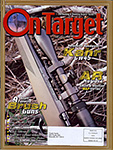
KAHR ARMS CW45
On Target, September/October 2009, p. 52 - 55
By Massad Ayoob
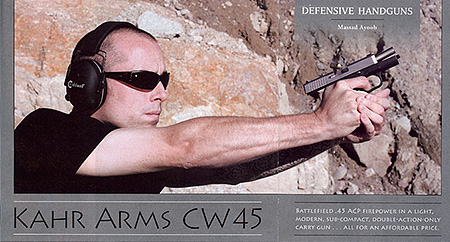
BATTLEFIELD .45 ACP FIREPOWER IN A LIGHT, MODERN, SUB-COMPACT, DOUBLE-ACTION-ONLY CARRY GUN … ALL FOR AN AFFORDABLE PRICE.
FOR WELL OVER A DECADE, Kahr Arms has been a strong force in the concealed-carry handgun market. Slim in profile due to single-stack magazines and some ingenious engineering, Kahr pistols can be made to disappear within almost any dress code. They are accurate and reliable, and their famously butter-smooth, double-action-only trigger pulls are easy to manipulate, not to mention giving peace of mind to many safety-conscious gun carriers.
Their pricing is commensurate with their quality, however. Like other finely-made handguns, they’re in the price range of a Glock or a Smith & Wesson, and sometimes a bit higher. The top-of-the-line Kahr .45 is the PM45 model, with an MSRP of more than a grand: the price for the PM45 with blackened stainless slide and factory-installed Tritium night sights is $1,022.
Seeing a need for good guns priced closer to “entry level,†Kahr introduced their CW series. The letters stand simply for “concealed weapon,†and it harkens back to the concept born with S&W’s Highway Patrolman revolver more than half a century ago. That is, take the fancy gun, omit some of the expensive machining operations that make it fancy, keep the proven internal mechanism exactly the same, give it a less-fine but still serviceable finish, and you can lower the price without lowering performance.
The subject of this article is the Kahr .45 with just that treatment: The CW45 pistol, with an MSRP of only $606.
FIRST LOOK
WITH A POLYMER FRAME and silvery stainless slide, this good-looking, 2-tone pistol comes out of the box with the sights Kahr has used since coming on the scene in the mid ‘90s. They’re rugged and fixed, with the von Stavenhagen pattern of a vertical white line below the rear notch that can mate with the large white dot on the front post. If there isn’t time for a precise post-in-notch sight picture, the shooter can simply “dot the i.â€
In the interest of reduced cost, some sculpting and machining on the slide has been skipped. It gives the gun a plainer look. but the front edge of the slide still tapers, in a chisel shape, toward the muzzle. This still allows very smooth and snag-free holstering.
The pistol is 6.07 inches long overall, with a 3.64-inch barrel. Weight is 19.7 oz. unloaded, plus two ounces for the empty magazine, only one of which is provided with the pistol. (Again, a cost-saving measure.) For rough comparison, this gives you a gun about the size and weight of the old Colt Detective Special 2-inch barrel revolver, but with seven rounds of .45 ACP instead of six .38 Specials. The CW45 magazine holds six of the fat .45 caliber sluggers, and the seventh may be carried safely in the firing chamber. (A slightly longer seven-round magazine is available from the factory.)
A brief digression is probably due at this point. In this day and age, some folks don’t think seven rounds is enough. We don’t have enough space here to debate that issue, but just for perspective, we should note that for most of the 20th Century it was generally acknowledged that American troops were considered the best-armed of any nation’s fighting men on the battlefield in terms of their service pistols. Their 1911 .45s were generally carried with the same complement of seven cartridges, with the chamber usually empty.
The CW45’s trigger pull is a stroke of about 0.70†in length, the long pull giving a mechanical advantage that makes it feel light. It broke at just under five pounds average on my Lyman digital trigger-pull gauge, and was exquisitely smooth. Clearly, there had been no cost-cutting here, and that’s hugely important to the handgun’s performance.
The slide stop/slide release lever is a MIM (metal-injection molded) part on the economy Kahrs, and it unfortunately has the same sharp edges of the machined slide stops on the early high-end Kahrs. Some of the latter have been rounded at the edges in recent production, and I much prefer this modification, as the sharp edges tend to slice my thumb when shooting right handed. With the CW45, I learned to live with it by firing with the Leatham/ Enos grasp, where the left thumb is straight forward along the frame and the right (firing) hand’s thumb is actually atop the thumb joint of the support hand, clear of the side of the pistol.
If one buys into the Kahr game with a $606 bet and comes to like this plain-Jane .45, the optional extra-cost night sights can be installed with a simple trip back to the factory. Due to the design of the Kahr pistol, I’ve found over the years that this is the best route for changing sights on this brand of handgun. No one knows how to do it better than the factory.
ACCURACY
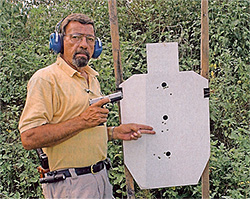 The author was pleased with this pistol’s 25-yard performance. The two fingers point to a tight double in the Black Hills 200-grain group. All groups were fired with the CW45 shown in-hand.
The author was pleased with this pistol’s 25-yard performance. The two fingers point to a tight double in the Black Hills 200-grain group. All groups were fired with the CW45 shown in-hand.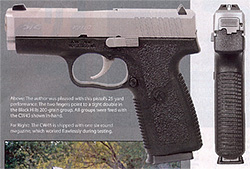
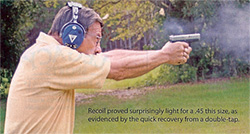 Recoil proved surprisingly light for a .45 this size, as evidenced by the quick recovery from a double-tap.
Recoil proved surprisingly light for a .45 this size, as evidenced by the quick recovery from a double-tap.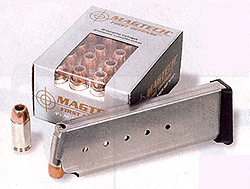 The CW45 is shipped with one six-round magazine, which worked flawlessly during testing.
The CW45 is shipped with one six-round magazine, which worked flawlessly during testing.I’VE BEEN BENCH-TESTING Kahr pistols since they first came out, and their history for me has been tremendous inherent accuracy, often somewhat marred by “4+1 syndrome,†a strong tendency for the first hand-chambered cartridge to send its bullet to a slightly different point of impact vis-à -vis point of aim than where it would print the rest of its automatically-cycled follow-up shots. In the 1911 platform, one of the reasons serious shooters pay $3,000 to $5,000 or more for a custom or semi-custom “boutique gun†is to keep this from happening. Even so, during the many years I shot the Bianchi Cup (which was accuracy intensive, and included a 50-yard component) I noticed many auto pistol shooters chose the option of leaving their guns hot with a mechanically-cycled round in the chamber and “tac-loading†between stages. When the great champions do this with their multi-thousand-dollar “match target custom automatics,†it reinforces the fact that “4+1†may be just one of those small prices the auto shooter has to pay.
This particular economy model Kahr pistol was only very slightly afflicted by “4+l.†I tested it with three proven brands in the three most popular bullet weights for .45 ACP: the traditional 230-grain, the 200-grain bullet, and the l85-grain that has proven both so accurate and so soft in recoil over the decades.
The “light†load was the 185-grain Winchester WinClean BEB (brass enclosed base). Off a concrete bench and MTM handgun rest at 25 yards, it put five consecutive shots into three inches even. (I measured all groups center-to-center, farthest to farthest shot, to the nearest 0.05â€.) The last four of those shots—the mechanically chambered ones—cut the group size by almost a third: they measured 2.05â€. And the best three were the tightest such cluster of the test, only 0.80†apart. That’s damn good accuracy for a pistol with a 3.6-inch barrel.
The “heavy†load was a 230-grain Mag Tech full metal jacket round. This load from South America is sold in this country as a generic, low-priced, training round, and in previous testing with other guns it has proven to be the most accurate round of the day. In this case, it delivered a respectable 3.25†cluster. If the first hand-cycled round is discounted, the group was exactly an inch tighter: those four shots went into 2.25â€, center to center. The best three—which experience has taught me will generally be in the ballpark for what the same gun and ammo will do for all five shots out of a machine rest—went 1.40â€. I was happy with that.
The “middle†load has more of a story behind it. “Back in the day,†Speer’s 200-grain jacketed hollow point was nicknamed “the flying ashtray†by the late, great gun writer and Outstanding American Handgunner Award recipient, Dean Grennell. He wasn’t exaggerating this bullet’s wide-mouth profile. In the time before high-tech bullets, this was the top-performing jacketed .45 hollow point in street shootings, because when it expanded, it expanded wide, and even when it didn’t it still chopped a wide track through flesh and bone. It was also the ultimate test of .45 auto pistol reliability, because its combination of wide frontal surface and relatively short overall length made it difficult to feed. It was also pretty darn accurate.
Well, during the testing session, I found an old box of Black Hills 200-grain JHP from back when that company was using the Speer bullet. (They now use the excellent Hornady XTP.) What, I thought, could be a better test of the Kahr .45’s functionality than this?
Five rounds of the old “flying ashtray†went through the CW45 without a bobble, like you-know-what through the proverbial goose. And when those bullets hit the target 25 yards away, all five were under two inches apart center-to-center: 1.90†to be exact. It was the best 5-shot group of the CW45 test. The 4+1 syndrome had been almost negligible with this load. Shots two through five measured 1.65â€, and the best three hits were in 1.10â€, the second best three-shot cluster of the test.
So how would I rate the CW45’s accuracy? For the pistol’s “mission profile†I was quite happy with it. Bear in mind that for many years conventional wisdom has held that a full-size service pistol only needs to meet a standard of four inches at 25 yards. This smaller, concealed carry gun was well inside that with every 5-shot group fired, and better than twice as good as that standard with the Black Hills ammo.
RELIABILITY
TO THE BEST OF MY knowledge, Kahr was the first pistol manufacturer to take the bold step of saying—flat-out—that their guns needed a 200-round break-in. Most auto pistols do, but I appreciate Kahr’s corporate honesty in frankly telling the consumer up front. In about that many assorted rounds, the closest to a cycling failure was when one shooter unfamiliar with the CW45 “rode†the slide with the support hand while chambering a round. This can cause any autoloader to fail to go into battery, as it did with this one. It was human error and I can’t hold it against the gun. The one problem we did have surfaced three times. Twice on the bench and once in offhand shooting, the magazine spontaneously ejected with one live round remaining. A call to Kahr confirmed that some CW45s had gotten out with a magazine release that was off a couple of degrees, allowing this to happen. A quick trip back to the factory got this squared away with a corporate apology. This is yet another reason to listen to Kahr and actually do the 200-round break-in.
BOTTOM LINE
WITH ITS AGGRESSIVELY stippled frame seating strongly in the hand, this little .45 proved to be fun to shoot—and easy to shoot well. At just over $600 MSRP the cost-cutting in the CW45 represents a huge saving to the consumer, while still delivering the core accuracy and “shootability†that have made Kahrs so popular. All things considered, the CW45 is a very neat little gun. See it at your gun shop, or for more information contact KAHR ARMS, Dept. OT; Tel.: (508) 795-3919; E-mail: sales@Kahr.com; Web: www.kahr.com
<< Go back to Previous Page